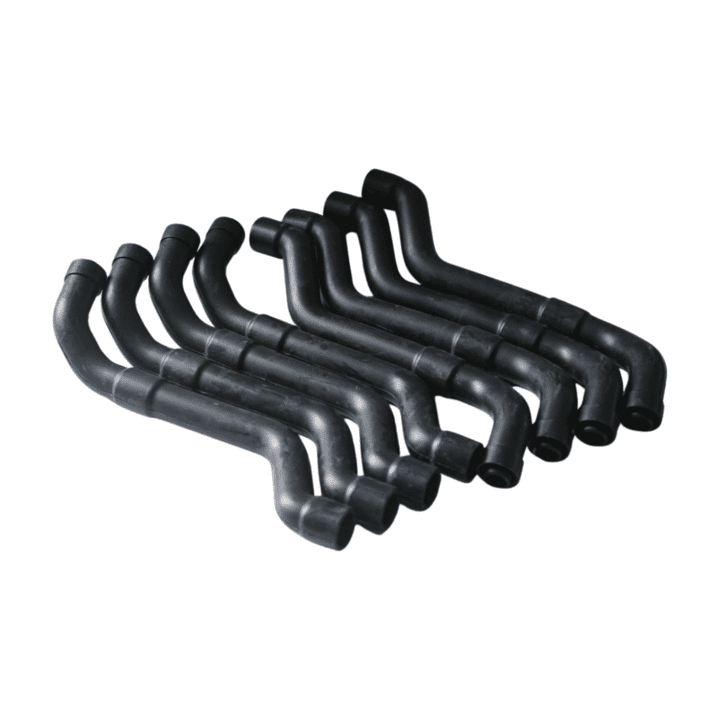Looking for a reliable hose material that can withstand extreme conditions and perform well in various industries? EPDM rubber hoses are a popular choice due to their durability, flexibility, and resistance to environmental factors. Let’s explore the uses and advantages of EPDM rubber hoses in various applications.
EPDM rubber hoses are known for their exceptional resistance to heat, ozone, UV, and weathering. They are widely used in automotive, industrial, and HVAC applications, offering flexibility and durability in harsh environments.

EPDM rubber hoses are favored for their versatility and resistance to various environmental stresses. Let’s take a deeper look at what makes these hoses so effective, their key applications, and the advantages they offer.
What Is EPDM Rubber?
Before we delve into the uses of EPDM rubber hoses, it’s important to understand what EPDM rubber is and what makes it such a reliable material for hoses.
EPDM stands for ethylene propylene diene monomer, a synthetic rubber that excels in resisting heat, ozone, and weathering. Its unique chemical structure makes it ideal for many industrial applications.
Rubber Material
EPDM rubber is made from the polymerization of ethylene, propylene, and a diene monomer. This combination gives it its excellent resistance to weathering, UV light, and extreme temperatures.
The ethylene and propylene base, combined with a diene monomer, creates a synthetic rubber that offers high flexibility, excellent resistance to environmental stress, and great performance in high-temperature applications1.
Types of EPDM Rubber
EPDM rubber2 comes in various grades, each tailored for specific applications. Let's break down the different types of EPDM rubber and their respective uses.
There are different grades of EPDM rubber, including standard, high-temperature resistant, and food-grade formulations, each offering specific properties suited to different environments.
Properties of EPDM Rubber
EPDM rubber is known for its impressive properties. Let’s take a closer look at its key characteristics that make it an ideal material for hoses.
EPDM rubber is flexible, durable, and resistant to heat, ozone, UV light, and weathering, making it an excellent choice for outdoor and high-temperature applications.
What Is an EPDM Rubber Hose Used For?
Now that we know about EPDM rubber, let’s explore the many uses of EPDM rubber hoses3 across various industries and applications.
EPDM rubber hoses are commonly used in automotive, industrial, agricultural, and HVAC systems due to their ability to withstand extreme temperatures, weather, and chemical exposure.
EPDM rubber hoses are versatile and are used in a range of applications where durability and flexibility are essential. These hoses can be found in:
Automotive: EPDM hoses are used for coolant lines, heater hoses, and air conditioning systems due to their heat resistance4 and ability to handle oils and coolants.
Industrial: EPDM hoses are widely used in industries such as manufacturing and chemical processing, where hoses must endure exposure to high temperatures and harsh chemicals.
Agricultural: EPDM hoses are used for irrigation systems, as they can handle exposure to UV light, moisture, and outdoor conditions.
HVAC: EPDM rubber hoses are commonly found in heating, ventilation, and air conditioning systems, providing reliable performance in systems exposed to high temperatures and varying environmental conditions.
| Industry | Application | Benefit of EPDM Rubber Hose |
|---|---|---|
| Automotive | Coolant, heater, and air conditioning hoses | High temperature and ozone resistance |
| Industrial | Fluid transfer systems, steam lines | Heat and chemical resistance5 |
| Agricultural | Irrigation, crop protection systems | UV, ozone, and weather resistance |
| HVAC | Air ducts, insulation hoses | Flexibility and durability |
What Are the Advantages of EPDM Rubber Hoses?
EPDM rubber hoses offer several advantages that make them the material of choice in demanding environments. Let’s look at why these hoses are so popular.
EPDM rubber hoses are known for their heat resistance, durability, and ability to withstand extreme weather conditions, making them ideal for outdoor and high-temperature applications.

Some of the standout advantages of EPDM rubber hoses include:
Heat Resistance: EPDM hoses can withstand temperatures up to 150°C, making them ideal for use in engines, industrial machinery, and HVAC systems.
Weather and UV Resistance: EPDM rubber is resistant to UV light, ozone, and weathering, which makes these hoses perfect for outdoor use, especially in agricultural, automotive, and construction environments.
Durability: EPDM hoses are long-lasting, even in harsh conditions. They maintain their flexibility and performance over time, ensuring reliable sealing and fluid transfer.
Flexibility: EPDM rubber hoses remain flexible even in low temperatures, allowing them to be used in a variety of environments and applications that require movement or bending.
| Advantage | EPDM Rubber Hose | Other Rubber Types |
|---|---|---|
| Temperature Resistance | Excellent (up to 150°C) | Varies, often lower than EPDM |
| Weather Resistance | High (resistant to ozone, UV, weather) | Varies |
| Durability | Long-lasting in harsh environments | Varies |
| Flexibility | Remains flexible even in low temperatures | Varies based on material |
Is EPDM Hose Safe for Drinking Water?
If you're concerned about using EPDM hoses for water-related applications, you might be wondering about its safety. Let’s clarify whether EPDM hoses are safe for drinking water.
Yes, certain grades of EPDM hoses are safe for drinking water. They are approved by relevant health authorities and meet regulatory standards for potable water applications.
EPDM hoses are often used in potable water systems, as they are compliant with regulatory standards such as NSF 616, which ensures that the material does not release harmful chemicals into drinking water. These hoses are made from non-toxic, food-grade EPDM, making them safe for water transport and treatment systems.
Is EPDM Hose Food Safe?
Many industries rely on EPDM hoses for food-related applications. Are these hoses truly food safe? Let's find out.
EPDM hoses can be food safe when made with FDA-approved materials7. They are commonly used in food processing and handling due to their resistance to moisture and heat.
EPDM hoses are used in food processing applications where hygiene and food safety are critical. FDA-approved EPDM rubber can withstand the high temperatures and cleaning cycles typically required in food manufacturing. These hoses also resist the absorption of oils and other contaminants, ensuring a safe environment for food processing.
Is EPDM Hose Safe for Brake Fluid?
EPDM hoses are used in many industrial applications, but can they handle brake fluid? Let’s see if EPDM rubber is compatible with brake fluid.
EPDM hoses are not typically recommended for brake fluid applications due to their chemical resistance limitations. Specialized hoses made from materials like nitrile or fluorocarbon rubber are preferred.
While EPDM hoses have excellent chemical resistance, they are not the best option for brake fluid applications. Brake fluid can cause EPDM rubber to swell or degrade over time. For brake systems, hoses made from nitrile rubber or fluorocarbon-based materials, which have superior resistance to oils and fuels, are generally preferred.
How Long Does EPDM Hose Last?
Wondering how long EPDM hoses can last before needing replacement? Let’s explore the expected lifespan of these hoses in various conditions.
EPDM hoses can last for several years, especially when exposed to mild conditions. However, their lifespan may vary depending on factors like temperature, UV exposure, and chemical exposure.
The lifespan of EPDM hoses depends on several factors, including environmental conditions and maintenance. Under normal conditions, EPDM hoses can last for 5-10 years, depending on their exposure to UV light, chemicals, and temperature extremes. Regular maintenance and inspection can help extend their lifespan, ensuring they continue to perform effectively.
| Factor | Impact on Lifespan |
|---|---|
| Temperature Exposure | EPDM hoses excel in high-temperature environments, extending lifespan |
| Chemical Exposure | Harsh chemicals can degrade EPDM rubber faster |
| Mechanical Stress | Prolonged bending or high pressure can reduce lifespan |
| Maintenance | Regular inspection and cleaning can extend lifespan |
Conclusion
EPDM rubber hoses are a versatile and durable solution for a wide range of applications, including automotive, industrial, agricultural, and HVAC systems. Their resistance to heat, ozone, and weathering makes them ideal for harsh environments. While they excel in many areas, it’s important to select the right material for specific applications, particularly when chemical resistance or food safety is a factor.
🚀 Need Custom EPDM Rubber Hoses for Your Industry?
Contact Julong Rubber today or Request a Custom Quote for high-quality EPDM rubber hoses tailored to your needs!
Learn about materials suitable for high-temperature applications and how EPDM rubber stands out in this category. ↩
Explore the benefits of EPDM rubber to understand its unique properties and applications across various industries. ↩
Discover the diverse applications of EPDM rubber hoses and how they enhance performance in automotive, industrial, and agricultural sectors. ↩
Learn how heat resistance in EPDM rubber enhances its performance in automotive and industrial applications. ↩
Discover the properties that make EPDM rubber hoses ideal for harsh chemical environments in industrial settings. ↩
Discover the significance of NSF 61 certification in ensuring safe drinking water systems and the materials used in them. ↩
Learn about the safety and compliance of FDA-approved materials in food processing to ensure quality and hygiene in your operations. ↩






